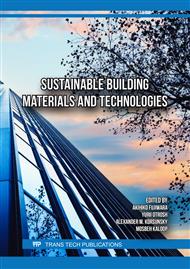[1]
T.F. Ryan, Gunite: A Handbook for Engineers, Cement and Concrete Association, London, 1973.
Google Scholar
[2]
S.A. Austin, P.J. Robins, Sprayed Concrete: Properties, Design and Application, Whittles Publishing, Caithness, 1995.
Google Scholar
[3]
T.R. Kuesel, E.H. King and J.O. Bickel, Tunnel Engineering Handbook, second ed., Springer, New York, 1996.
Google Scholar
[4]
E. Bilotta, R. Casale, C. Giulio di Prisco, S. Miliziano, D. Peila, A. Pigorini and E.M. Pizzarotti, Handbook on Tunnels and Underground Works, CRC Press, Leiden, 2022.
DOI: 10.1201/9781003306467
Google Scholar
[5]
J. How, A. Vijayan and T.M. Wong, Decompression sickness in the Singapore Mass Rapid Transit project, Singapore Med. J. 31(6) (1990) pp.529-538.
Google Scholar
[6]
R.C.T. Li, Oxygen decompression may prevent dysbaric osteonecrosis in compressed air tunnelling, in: The 3rd Conference U.S. Japan Panel on Aerospace, Diving Physiology & Technology and Hyperbaric Medicine, Nakatsu, Japan, 2008, 126-131.
Google Scholar
[7]
S.A. Austin, Sprayed Concrete Technology, CRC Press, Boca Raton, 2014.
Google Scholar
[8]
A. Thomas, Sprayed Concrete Lined Tunnels, second ed., CRC Press, Boca Raton, 2020.
Google Scholar
[9]
V. Ramakrishnan, W.V. Coyle, L.F. Dahl and E.K. Schrader, A comparative evaluations of fiber shotcretes, Concr. Int. 3(1) (1981) 59-69.
Google Scholar
[10]
N. Banthia, J.-F. Trottier and D. Beaupré, Steel-fiber-reinforced wet-mix shotcrete: comparisons with cast concrete, J. Mater. Civ. Eng. 6(3) (1994) 430-436.
DOI: 10.1061/(asce)0899-1561(1994)6:3(430)
Google Scholar
[11]
N. Banthia, J.-F. Trottier, D. Beaupré and D. Wood, Properties of steel fiber reinforced shotcrete, Can. J. Civ. Eng. 21(4) (1994) 564-575.
DOI: 10.1139/l94-058
Google Scholar
[12]
C.K.Y. Leung, R. Lai and A.Y.F. Lee, Properties of wet-mixed fiber reinforced shotcrete and fiber reinforced concrete with similar composition, Cem. Concr. Res. 35(4) (2005) 788-795.
DOI: 10.1016/j.cemconres.2004.05.033
Google Scholar
[13]
H.D. Li, D.M. Yan, G.D. Chen, S.L. Xu, J.T. Liu and Y.J. Hu, Porosity, pore size distribution and chloride permeability of shotcrete modified with nano particles at early age, J. Wuhan Univ. Technol. Mater. Sci. Ed. 31(3) (2016) 582-589.
DOI: 10.1007/s11595-016-1413-9
Google Scholar


